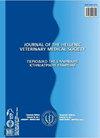家禽沙门氏菌分离株的回顾性研究
IF 0.4
4区 农林科学
Q4 VETERINARY SCIENCES
引用次数: 0
摘要
家禽是沙门氏菌重要的全球宿主。家禽沙门氏菌病造成巨大的经济损失,一些血清型也有人畜共患的可能。一些感染沙门氏菌的家禽可能没有表现出疾病的临床症状,但它仍然是感染传播的一个重要来源。临床症状包括消化问题(白色腹泻、吸收不良)、菌血症和死亡。本研究旨在回顾性分析贝尔格莱德流行病学区6年(2014-2019年)家禽中不同血清型肠沙门氏菌亚种肠沙门氏菌的存在情况。共检测样品4580份,包括:孵蛋、死鸡、肉鸡粪便和蛋鸡,阳性样品207份。采用标准微生物学方法分离沙门氏菌,并进行血清学分型。调查期间,禽沙门氏菌患病率为4.52%。检测样本数量最多的是2017年(879),阳性样本数量最多的是2018年(65),而患病率最低的是2016年,阳性样本数量为7。在所有分离的血清型沙门氏菌中,最常见的是肠炎沙门氏菌(65.28%),其次是婴儿沙门氏菌(21.30%)、姆班达卡沙门氏菌(6.02%)、森夫登堡沙门氏菌(3.24%)、鼠伤寒沙门氏菌(1.85%)、阿戈那沙门氏菌(0.93%)、Taksony沙门氏菌(0.93%),最常见的是Tshiongwe沙门氏菌(0.46%)。2018年首次报告了S. Agona、S. Taksony和S. Tshiongwe。阳性标本最多的是蛋鸡面部(921例中116例)、肉鸡面部(1147例中73例)、鸡尸体(1443例中12例)和孵蛋(1069例中6例)。从生产中完全根除沙门氏菌是一个困难的目标,因为存在异质血清型池和各种感染源。预防是控制沙门氏菌的最佳工具:卫生、生物安全以及在适用的情况下接种疫苗。应用现有标准并改进新标准是家禽养殖户的重大责任。本文章由计算机程序翻译,如有差异,请以英文原文为准。
A retrospective study on the isolated strains of Salmonella in poultry
Poultry represent an important global reservoir of Salmonella. Poultry salmonellosis results in great economic losses, and some serovars also have zoonotic potential. Some poultry can be infected with Salmonella without showing clinical signs of the disease, but is, nevertheless, a significant source of spread of the infection. Clinical symptoms range from digestive problems (white diarrhea, malabsorption) to bacteremia and death. The aim of this study was to retrospectively show the presence of bacteria Salmonella enterica subspecies enterica of various serovars in poultry in the Belgrade epizootiological area in a period of six years (2014-2019). A total of 4580 samples were examined including: incubated eggs, dead chickens, broiler feces and laying hens with total of 207 positive samples. Salmonella was isolated by standard microbiological methods followed by serological typing. In the examined period, the prevalence of poultry salmonella was 4.52%. The highest number of examined samples was recorded in 2017 (879), and positive in 2018 (65), while the lowest prevalence was recorded during year 2016 with 7 positive samples. Of all isolated and serotyped Salmonella, the most commonly isolated serovar was S. Enteritidis (65.28%), followed by S. Infantis (21.30%), S. Mbandaka (6.02%), S. Senftenberg (3.24%), S. Typhimurium (1.85%), S. Agona (0.93%), S. Taksony (0.93%), and the least common is S. Tshiongwe (0.46%). The first report of serovars : S. Agona, S. Taksony and S. Tshiongwe have been during 2018. The highest number of positive specimens was found in laying hens faces (116 of 921 tested), broiler faces (73 of 1147), chickens carcasses (12 of 1443) and incubated eggs (6 of 1069). Complete eradication of Salmonella from production is a difficult goal because of the presence of a heterogeneous serovars pool and various sources of infection. Prevention is the best tool for controlling Salmonella: hygiene, biosecurity and where applicable - vaccination. It is a great responsibility of the poultry farmers to apply the existing standards and to improve the new ones.
求助全文
通过发布文献求助,成功后即可免费获取论文全文。
去求助
来源期刊

Journal of the Hellenic Veterinary Medical Society
VETERINARY SCIENCES-
CiteScore
0.60
自引率
0.00%
发文量
83
审稿时长
>12 weeks
期刊介绍:
The Journal of the Hellenic Veterinary Medical Society (J Hellenic Vet Med Soc) is a quarterly peer-reviewed journal that publishes articles in all aspects of veterinary science and related disciplines. It is published by the Hellenic Veterinary Medical Society and is indexed in the Web of Science and in Scopus.
There are no publication fees in the journal. Authors considering submitting manuscripts for evaluation and publication are requested to read carefully the instructions for authors and fully comply with them.
Non-complying manuscripts may be returned to the corresponding author for formatting.
 求助内容:
求助内容: 应助结果提醒方式:
应助结果提醒方式:


